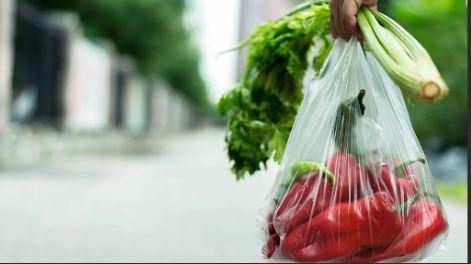
When you completely seal vegetables in plastic, the natural moisture (vapor) that comes out of them gets trapped inside.
Vegetables rot quickly because moisture is trapped in plastic…
When you completely seal vegetables in plastic, the natural moisture (vapor) that comes out of them gets trapped inside. This humid environment creates a breeding ground for bacteria and fungi. As a result, instead of staying fresh, the vegetables start to rot quickly and become slimy.
Vegetables spoil quickly due to ethylene gas in plastic….
Fruits and vegetables naturally release a gas called ‘ethylene’, which causes them to ripen. This gas is trapped in a plastic bag, and its concentration increases. This increased gas causes the vegetables to ripen more quickly and more quickly, which makes them spoil faster and also spoils their taste.
Nutrients are lost due to lack of air circulation in plastic…
Vegetables are ‘alive’ even after they are cut and need air to breathe. Plastic bags prevent air from circulating and suffocate the vegetables. This causes them to lose essential nutrients like vitamins and minerals faster.
Chemical Leaching…
Many plastic bags, especially low-quality ones, contain harmful chemicals like Bisphenol A (BPA) and Phthalates. When vegetables come into contact with this plastic, there is a risk of these chemicals leaching into the vegetables. Eating such vegetables can have serious health consequences.
Plastic bags increase cancer risk…
Eating food that has been in contact with plastic for a long time can lead to harmful chemicals accumulating in the body. According to some studies, this can increase the risk of serious diseases like cancer in the future.
So how should vegetables be stored? What is the right method?
Cloth or cotton bags: Cloth or jute bags are the best option for storing vegetables. This allows air circulation and absorbs excess moisture.
Use of paper towels: Leafy greens (e.g. coriander, spinach) stay fresher for longer if they are washed and wrapped in paper towels.
Airtight containers: You can store cut vegetables in airtight containers made of steel or good quality food-grade plastic.
Directly in the crisper drawer: Vegetables like carrots, cucumbers, beets can be stored directly in the crisper drawer of the fridge without any bags.
Although it may seem convenient, break the habit of storing vegetables in plastic today. With a small change, you can keep your vegetables fresher for longer and keep your family healthy.

प्लॅस्टिकमध्ये भाज्या ठेवण्याचे 5 मोठे तोटे…
जेव्हा तुम्ही भाज्या प्लॅस्टिकमध्ये पूर्णपणे बंद करून ठेवता, तेव्हा त्यातून बाहेर पडणारा नैसर्गिक ओलावा (बाष्प) आतच कोंडला जातो.
प्लॅस्टिकमध्ये ओलावा कोंडून भाज्या लवकर सडतात…
जेव्हा तुम्ही भाज्या प्लॅस्टिकमध्ये पूर्णपणे बंद करून ठेवता, तेव्हा त्यातून बाहेर पडणारा नैसर्गिक ओलावा (बाष्प) आतच कोंडला जातो. या दमट वातावरणामुळे जिवाणू (Bacteria) आणि बुरशी (Fungus) वाढण्यासाठी पोषक स्थिती निर्माण होते. परिणामी, भाज्या ताजे राहण्याऐवजी लवकर सडू लागतात आणि चिकट होतात.
प्लॅस्टिकमध्ये इथिलीन वायूमुळे भाज्या लवकर खराब होतात…
फळे आणि भाज्या नैसर्गिकरित्या ‘इथिलीन’ नावाचा वायू सोडतात, ज्यामुळे त्या पिकण्याची प्रक्रिया होते. प्लॅस्टिकच्या पिशवीत हा वायू बंदिस्त झाल्यामुळे त्याचे प्रमाण वाढते. या वाढलेल्या वायूमुळे भाज्या गरजेपेक्षा जास्त आणि लवकर पिकतात, ज्यामुळे त्या लवकर खराब होतात आणि त्यांची चवही बिघडते.
प्लॅस्टिकमध्ये हवा खेळती न राहिल्याने पोषक तत्वे नष्ट होतात…
भाज्या तोडल्यानंतरही ‘जिवंत’ असतात आणि त्यांना श्वास घेण्यासाठी हवेची गरज असते. प्लॅस्टिकच्या पिशवीमुळे हवा खेळती राहत नाही आणि भाज्यांचा श्वास गुदमरतो. यामुळे त्यांच्यातील जीवनसत्त्वे आणि खनिजे यांसारखी आवश्यक पोषक तत्वे वेगाने नष्ट होतात.
रसायनांचा धोका (Chemical Leaching)…
अनेक प्लॅस्टिकच्या पिशव्या, विशेषतः कमी दर्जाच्या पिशव्यांमध्ये ‘बिस्फेनॉल ए’ (BPA) आणि ‘फ्थॅलेट्स’ (Phthalates) सारखी हानिकारक रसायने असतात. जेव्हा भाज्या या प्लॅस्टिकच्या संपर्कात येतात, तेव्हा ही रसायने भाज्यांमध्ये मिसळण्याचा धोका असतो. अशा भाज्या खाल्ल्याने आरोग्यावर गंभीर परिणाम होऊ शकतो.
प्लॅस्टिकच्या पिशवीमुळे कर्करोगाचा धोका वाढतो…
दीर्घकाळ प्लॅस्टिकच्या संपर्कात राहिलेले अन्नपदार्थ खाल्ल्याने शरीरात हानिकारक रसायने जमा होतात. काही अभ्यासांनुसार, यामुळे भविष्यात कर्करोगासारख्या गंभीर आजारांचा धोका वाढू शकतो.
मग भाज्या कशा साठवाव्यात? योग्य पद्धत कोणती?
कापडी किंवा सुती पिशव्या: भाज्या साठवण्यासाठी कापडी किंवा ज्यूटच्या पिशव्या हा सर्वोत्तम पर्याय आहे. यामुळे हवा खेळती राहते आणि अतिरिक्त ओलावा शोषला जातो.
पेपर टॉवेलचा वापर: पालेभाज्या (उदा. कोथिंबीर, पालक) स्वच्छ करून पेपर टॉवेलमध्ये गुंडाळून ठेवल्यास त्या अधिक काळ ताज्या राहतात.
हवाबंद डबे (Airtight Containers): कापलेल्या भाज्या स्टीलच्या किंवा चांगल्या दर्जाच्या फूड-ग्रेड प्लॅस्टिकच्या हवाबंद डब्यात ठेवू शकता.
थेट क्रिस्पर ड्रॉवरमध्ये: गाजर, काकडी, बीट यांसारख्या भाज्या कोणत्याही पिशवीशिवाय थेट फ्रीजच्या क्रिस्पर ड्रॉवरमध्ये ठेवल्या तरी चालतात.
सोयीस्कर वाटत असली तरी, प्लॅस्टिकमध्ये भाज्या साठवण्याची सवय आजच सोडा. छोट्याशा बदलामुळे तुम्ही भाज्या अधिक काळ ताज्या ठेवू शकाल आणि आपल्या कुटुंबाला निरोगी ठेवू शकाल.
